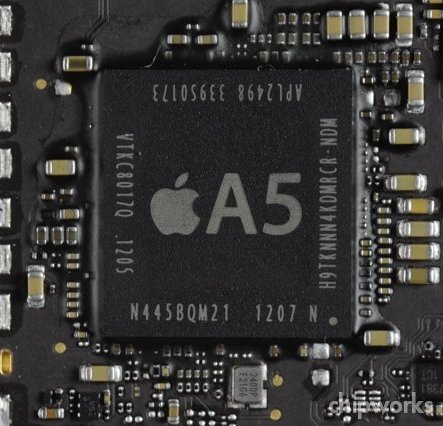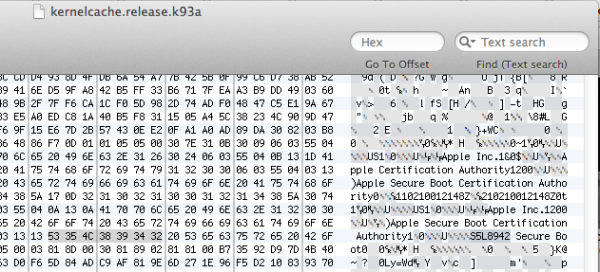Apple's iPad 2,4 also uses 32nm A5 S5L8942 SoC
by Brian Klug on April 11, 2012 2:27 PM ESTThrough Chipworks, we recently learned that Apple's revised A5 SoC (S5L8942) is built on a 32nm Samsung HKMG process. While its presence in the Apple TV (3rd generation) which we've reviewed and inspected is an absolute certainty, up until recently it hasn't been as common knowledge that the iPad 2,4 ($399 cost reduced Wi-Fi model) also contains the same S5L8942 SoC but with both A9 cores enabled, as opposed to the single core A9 configuration of the Apple TV 3.
To quell any possible naysayers, I grabbed the "iPad2,4_5.1_9B176_Restore" image a while ago, opened it up, and inspected the kernelcache for references to S5L8942, which there are. Note that the iPad2,4 is k93aap, there are numerous other references to S5L8942 elsewhere, including the buildmanifest plist, eg "Firmware/all_flash/all_flash.k93aap.production/glyphcharging.s5l8942x.img3." There's no question about S5L8942 (A5R2) being inside iPad2,4.
The end result is that if you're an iPad2,4 owner, you've got Samsung 32nm HKMG silicon inside. There's no doubt about iPad2,4 being out and in the wild either, as a number of geekbench 2 runs have popped up since release on their online result browser, which I've been watching like a hawk. As an aside, performance between the S5L8942 (A5R2) and S5L8940 (A5) is virtually unchanged between the iPad2,4 and iPad2,1 if you compare runs on the result browser.
The interesting other question is whether iPad2,4 owners have improved battery life compared to those with iPad2,1 (WiFi), though admittedly that's not going to be a common upgrade path for existing iPad 2 owners to check out. I no longer own an iPad 2 but am going to set out to measure and compare to see just how much of a difference there is, which in turn might say something interesting about Samsung's 32nm HKMG process.
Overall, Apple porting the existing A5 design to Samsung's 32nm HKMG process makes a lot of sense to both test the waters and figure out any design issues, as well as not jeopardize production for the high end. At this point seeing another future Apple product using Samsung 32nm HKMG would not be very surprising.

32nm A5 in iPad 2,4 (Source: Chipworks)
Update: Chipworks has also updated and confirmed with a teardown of an iPad2,4 that the expected 32nm A5 S5L8942 is indeed inside.











28 Comments
View All Comments
Brian Klug - Wednesday, April 11, 2012 - link
Ahh, now that's an interesting theory. I really hope there's some availability here in the US so I can find one, but I think there might be a chance the 2,4 is being sold under the same model number as the 2,1. Again, not 100% sure.-Brian
ltcommanderdata - Wednesday, April 11, 2012 - link
Presuming there are battery life improvements to be had in the new iPad2,4, I wonder why the 32nm A5 wasn't adopted for 3G iPad 2 models since they would need it the most? Maybe that's a sign that yields aren't where they should be yet.Aries1470 - Monday, April 16, 2012 - link
Simple answer, the CPU does not do communications. That is handled by a different chip altogether. So, in essence only if you were using a CPU hungry app will it make a difference.peroni - Wednesday, April 11, 2012 - link
Just got myself an ipad2 wifi and it is a 2,1 according to the IOS update file itunes tries to downloadBrian Klug - Wednesday, April 11, 2012 - link
Interesting, so it's still very possible there are "iPad 2 WiFi" models out there which are still 2,1, sort of a luck of the draw thing whether you get 2,4.-Brian
Stanly.ok - Wednesday, April 11, 2012 - link
did anyone notice that Apple is doing* a "tick" and a "tock" at the same time? ((=*via its partners, of course
KingKuei - Wednesday, April 11, 2012 - link
The model has served Intel quite well and it's one that Apple seems to have adopted in recent years, iPhone and iPad being prime examples. A5X is clearly a "tick", but 2012 iPhone should be a "tock". Perhaps Apple is staggering tick-tock schedules for SoC and other hardware. This would provide the benefit of allowing them to focus on "tock" design changes to the screen, body, antenna, etc., while implementing a more mature SoC architecture, then vice versa the following year. It reduces the number of unknown variables from year to year and each generation will still provide something worthwhile for people to upgrade for.psychogmv - Thursday, April 12, 2012 - link
Would this processor eventually come to the New iPad? Isn't it a reference to a iPad3,3 in the iOS 5.1 already? This would make things interesting, with less heating and higher battery duration.tipoo - Thursday, April 12, 2012 - link
I was under the impression the extra heat was from having two LED strips for the screen instead of the old single strip, the SoC is still under 2W in power so it shouldn't make that much heat.Steelbom - Saturday, April 14, 2012 - link
It's actually about 3w at full load, if I remember correctly.